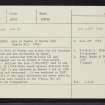Following the launch of trove.scot in February 2025 we are now planning the retiral of some of our webservices. Canmore will be switched off on 24th June 2025. Information about the closure can be found on the HES website: Retiral of HES web services | Historic Environment Scotland
Forfar, Castle Hill
Castle (Medieval)
Site Name Forfar, Castle Hill
Classification Castle (Medieval)
Canmore ID 33763
Site Number NO45SE 19
NGR NO 45614 50813
Datum OSGB36 - NGR
Permalink http://canmore.org.uk/site/33763
- Council Angus
- Parish Forfar
- Former Region Tayside
- Former District Angus
- Former County Angus
NO45SE 19 4563 5080.
(NO 4563 5080) Site of Castle of Forfar (NR)
Castle Hill (NAT)
OS 25" map, Forfarshire, (1861)
The Castle Hill of Forfar was within the old boundary of the loch and was surrounded by water. The castle is associated with Malcolm III and Queen Margaret and is on record at this period (1057-93). William the Lion (1165-1214) used it and Alexander II (1214-1249) dated several charters from it. In 1291 it was captured by Edward I and in 1306 was burned and destroyed. It was restored in 1308 but in 1313 it was again destroyed and never rebuilt, The remains were visible in the 17th century but all trace has now disappeared.
A Jervise 1859; A Reid 1902.
Publication Account (1981)
Tradition maintains that there were two castles at Forfar, and one noted Forfarshire historian, Andrew Jervise, cited the unreliable Hector Boece as his evidence. Boece is alleged to have written that Forfar was strengthened with 'two roiall castles, as the ruins doo yet declare' (Jervise, 1885, i, 40). William the Lion (1165 x 1214) is supposed to have granted Robert de Quinci, a leading AngloNorman baron, a plot (placia) in the old castle of Forfar in lieu of a toft (Barrow, 1971, 479). It is this 'old castle' which is purported to have stood upon an island, a crannog, called Queen Margaret's Inch on the north side of Forfar Loch (Jervise, 1885, i, 40). However, the Inch is also supposed to have been 'a place of religious retirement for Queen Margaret', consort of Malcolm Canmore ' (OSA, 1793, vi, 528), and in history the Inch did have a religious connection. By his second charter of confirmation of 1234, Alexander II granted to the monks of Coupar Angus donations for the maintenance of two monks who were to celebrate in a chapel on an island in Forfar Loch (Easson, 1947, l xviii ).
Centuries later, in 1508, the abbot and convent of Coupar Angus granted for life to Sir Alexander Turnbull, chaplain,their chaplaincy of St.Margaret's Inch, in the Loch of Forfar, charging him to see to the building and repair of the chapel (Stuart, 1865, 143).
Castle Hill in the centre of town provides perhaps a more attractive setting for a royal castle. The mound on which the castle stood is nearly fifty feet high and had at one time been moated. Tradition says that Wallace burned the royal castle in the early phase of the Wars of Independence, for in midsummer of 1306, Alexander de Abernethy informed Edward I that he found the castle of Forfar burned and destroyed, and the wall around it much dispersed (Reid, 1902, 20). Whether the English held the structure throughout the whole conflict is uncertain, although it is presumed that Bruce issued orders for its final demolition.
Information from ‘Historic Forfar: The Archaeological Implications of Development’ (1981).










